3
Conceptual Approaches and Frameworks
In this session of the workshop, speakers discussed conceptual approaches and frameworks for studying mobility, and shared their perspectives on areas for future work in this area.
CAUSAL INFERENCE
In a causal framework of mobility, said Jennie Brand (University of California, Los Angeles), “origin” can be seen as the treatment condition, while “destination” is the outcome. For example, origin could be parental income, and destination could be the children’s income. The causal framework extends most easily to a dichotomous treatment condition, said Brand, comparing “treatment” to the counterfactual of “no treatment.”
However, mobility measures are not usually dichotomous, so researchers often use categories such as income quintiles and occupational categories. If five or 10 categories are created, the set of possible counterfactuals is quickly complicated. For example, comparing the bottom quintile with the top quintile may not be a realistic alternative or counterfactual condition. Income could also be measured as a continuous treatment, but here the problem of possible counterfactuals becomes severe. For example, it would be difficult to find a family for whom every income from $10,000 to $150,000 is a reasonable counterfactual to consider. Another challenge, said Brand, is the issue of selection. If there is an observed association between parent and child income, there is little basis for concluding that it is a causal association. There could be any number of pretreatment characteristics that impact both parent and child income. Figure 3-1 demonstrates this relationship, and how pretreatment characteristics (X) can be a cause of the correlation between incomes. These characteristics can be adjusted for using regression, matching, weighting, or machine learning approaches. If all known confounders are adjusted for, the association between parent and child incomes might be a true causal relationship. However, she said, there could be unobserved factors (U) that impact both incomes and bias the causal association (e).
A common research question is what role education plays in mobility, said Brand. She shared an “OED triangle,” in which education is a primary mediator by which origins impact destinations (see Figure 3-2). Since paths b and c are strong, she said, education preserves privilege across generations and transmits social origins to destinations, thus playing a key role in social reproduction. However, education also facilitates equal opportunity to the extent that access to higher education results from factors other than

SOURCE: Workshop presentation by Jennie Brand, February 14, 2022.

SOURCE: Workshop presentation by Jennie Brand, February 14, 2022.
social origins (e1). There are large bodies of literature that aim to identify the causal effects of family background (e.g., parent income) on educational attainment (path b), and of education on destination (path c). Many of the same issues arise in this research as in the previous example, said Brand, in particular difficulty operationalizing education as a treatment. Researchers could examine preschool, secondary school, higher education, or any combination of these; even within higher education, one could look at college attendance, college completion, type of institution attended, or years of higher learning.
Causal Mediation Analysis
These paths can be considered using causal mediation analysis, which allows researchers to assess mechanisms through which treatments affect outcomes, said Brand. The goal of causal mediation analysis is to decompose the total effect of origins on destinations into direct and mediating or indirect effects through education. The mediating effect, she explained, reflects one potential pathway through which the treatment produces an effect on the outcome of interest. For example, early mobility research found that a college education mediates the mobility process and serves as an equalizer. This is illustrated hypothetically in Figure 3-3, where there is little direct relationship between origins and destinations for college-educated workers; thus, college serves as an equalizer. There is a stronger relationship between origins and destinations among less educated workers, showing that intergenerational mobility is higher among college graduates than among people with lower levels of education.
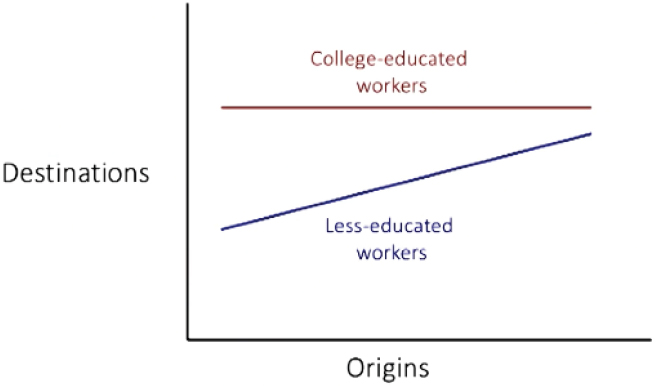
SOURCE: Workshop presentation by Jennie Brand, February 14, 2022.
However, according to Brand, recent research has questioned this relationship and has noted that the college equalization finding rests on an implicit assumption that the high mobility observed among college graduates reflects a causal effect of college on intergenerational mobility. An alternative explanation, she said, is that college graduates from low-income families may be more positively selected on attributes such as motivation than graduates from higher-income families for whom college attendance is a cultural norm. In this scenario, education is not only a mediator but also a common consequence of both social origins and other pretreatment characteristics (X); Figure 3-4 adds pretreatment characteristics to the OED triangle shown in Figure 3-2 above.
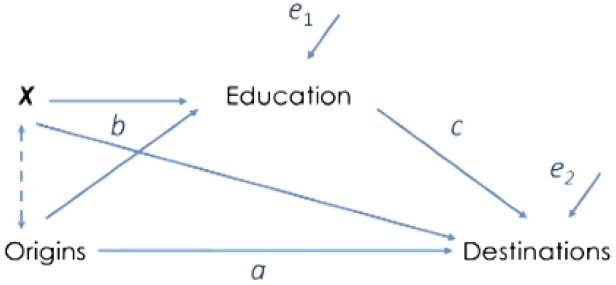
SOURCE: Workshop presentation by Jennie Brand, February 14, 2022.
Brand indicated that researchers have recently used a variety of methods to adjust for pretreatment conditions and to tease out the relationship between education and destination.
Heterogeneous Causal Effects
Another area of recent interest, said Brand, is looking at the variation or distribution of effects. For example, a researcher could explore how path c (education to destination) varies by social origin. As seen in Figure 3-5, examining the differences in destination between college-educated and less-educated workers at each level of social origin allows one to consider heterogeneous college effects. In this example, those with more disadvantaged social origins have larger observed returns from college than those with more advantaged social origins. This approach, said Brand, is useful for assessing how mobility processes vary across the population, and for attending to external validity. However, Brand continues, this type of analysis depends on researchers’ a priori ideas of important sources of variation. Emerging machine learning methods can allow researchers to explore sources of variation that they may not have considered, and to identify subpopulations defined by effect heterogeneity.
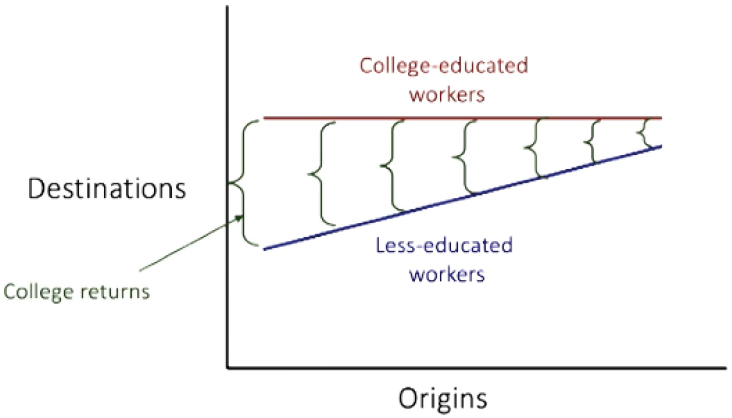
SOURCE: Workshop presentation by Jennie Brand, February 14, 2022.
INTEGRATING INTERGENERATIONAL AND INTRAGENERATIONAL MOBILITY
Traditional mobility research relies on single point measures in the parent and offspring generation, said Xi Song (University of Pennsylvania). However, parents and offspring overlap in their life courses, which means that transitions, turning points, and stages when careers develop may have implications for intergenerational mobility. Song presented two examples to demonstrate why taking a life course perspective is important for understanding intergenerational mobility. She began by explaining intergenerational income elasticity, which is typically assessed by regressing the offspring’s log income on the parents’ log income, and uses a static approach of either a snap-shot or a multi-year average. Figure 3-6 shows a summary of research; as the number of years averaged increase, intergenerational income elasticity also increases. However, said Song, much of the current understanding of rising intergenerational mobility may be related to the types of data and methods in use.
Song described a linked mobility trajectory framework that can further understanding of how life courses across generations are associated. Trajectories over life courses can be decomposed into four components: initial positions, growth rates, growth deceleration, and growth volatility. Using income as an example, initial positions refer to the income at the beginning

SOURCE: Workshop presentation by Xi Song, February 14, 2022.
of an individual’s career. Growth rate is the percentage growth in income over time, and growth deceleration refers to a slowing of this growth. Volatility is fluctuations in income over the life course. A linked mobility trajectory framework allows researchers to consider correlations between parents and their offspring across all of these dimensions, said Song. She shared an example of a heat map that shows correlations between father and son incomes at different ages (see Figure 3-7). The heat map, said Song, shows the “long arm of childhood.” The strongest association is not between the prime working years of father and son, but instead between the fathers’ early careers and the sons’ prime working years.
Song’s second example of a life course perspective on mobility focused on the trajectory of income over an individual’s life. A traditional mobility probability table can be used to show a child’s chances of reaching the top quintile of the income distribution, based on his father’s income quintile (see Figure 3-8). The highlighted column indicates a child’s chances of success, namely the probability that a child reaches the top quintile of the income distribution.1
A life course perspective, on the other hand, Song explained, considers income quintiles as dynamic rather than static; people may belong to different income quintiles at different points in their lives. For example, Figure 3-9
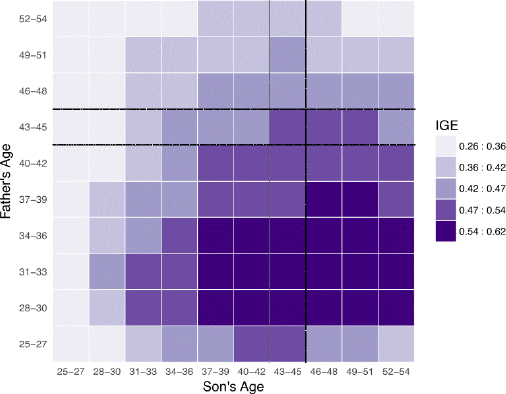
SOURCE: Workshop presentation by Xi Song, February 14, 2022.
___________________
1 See Chetty, R., Hendren, N., Kline, P., and Saez, E. 2014. Where is the land of opportunity? The geography of intergenerational mobility in the United States. The Quarterly Journal of Economics, 129(4), 1553-1623.
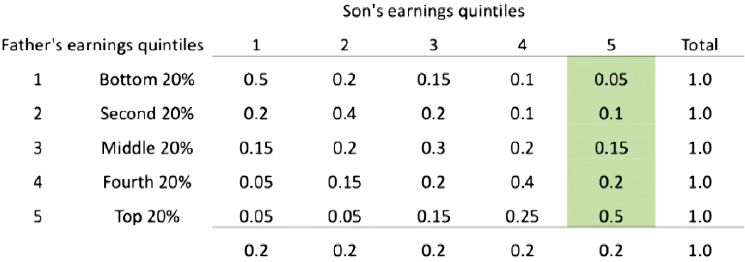
SOURCE: Workshop presentation by Xi Song, February 14, 2022.
shows how different groups vary in both their income as well as the trajectory and stability of their income. Song said that, when comparing the mobility table to the income trajectory approach, the trajectory approach reveals substantially higher intergenerational association than the income quintile approach. This means that the static approach, which ignores intragenerational mobility, may underestimate the amount of intergenerational association. Parents and offspring may resemble each other, said Song, in both their level of income and also in the shape of their income trajectory over the life course.
Americans have experienced fundamental changes in their working lives because of rising inequality over the last five decades, and changes in the economic status over the life cycle may have intergenerational consequences, said Song. To better understand how these changes persist into the
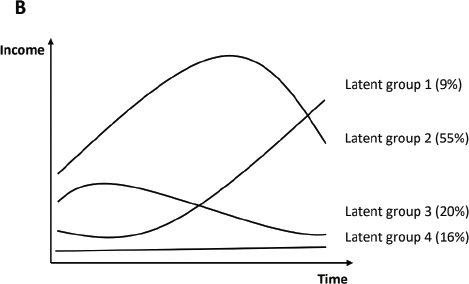
SOURCE: Adapted from Nagin, D.S., and R.E. Tremblay. 2005. Developmental trajectory groups: Fact or a useful statistical fiction? Criminology 43, 873-904. Maughan, B. 2005. Developmental trajectory modeling: A view from developmental psychopathology. The Annals of the American Academy of Political and Social Science 602(1), 118-130. Workshop presentation by Xi Song, February 14, 2022.
next generation, future research should incorporate a linked-lives perspective across generations, among family members, or between individuals. This type of approach, she said, can improve understanding of how inequality is produced and reproduced in society.
INTERVENTIONS TO INCREASE MOBILITY
A great deal of attention is paid to interventions designed to help young people move up the mobility ladder, said Greg Duncan (University of California, Irvine). In 2019, the National Academies published a report called A Roadmap to Reducing Child Poverty; the report set the goal of developing policies and programs that could reduce child poverty by 50 percent within 10 years. This report gave rise to a new committee that has the goal of identifying policies and programs with the potential to reduce long-term, intergenerational poverty.2
Duncan began by describing the distinction advanced by Peter Rossi3 between problem theory and program theory in the field of mobility. Problem theory—which the majority of this workshop has been about thus far—is understanding the social processes that give rise to the problem of intergenerational immobility. Program theory, on the other hand, is understanding how to translate problem theory into specific programs and policies. Sometimes, Duncan said, policy implications are included with a “throwaway couple of paragraphs” at the end of a research article. This approach is problematic, because program theory is a field unto itself, and even a deep understanding the problem tells you “virtually nothing” about what the best interventions are. For example, it may be clear that family structure is an important determinant of intergenerational mobility, but it is far less clear what policy makers should do with this information.
Duncan focused on the specific example of early childhood education (ECE) and introduced workshop participants to the Heckman curve (see Figure 3-10). This figure provides a visualization of the potential economic impact of additional investments in education; given the status of current investments, “where should additional money go that has the highest return to long-run human capital?” Heckman’s hypothesis, said Duncan, is that investments in early childhood education have the “biggest bang for the buck,” and the impact of investments decreases as the targets of the intervention get older. There is evidence both supporting and contradicting
___________________
2https://www.nationalacademies.org/our-work/policies-and-programs-to-reduce-intergenerational-poverty
3 Rossi, P.H. 1987. The iron law of evaluation and other metallic rules. In J. Miller and M. Lewis (Eds.), Research in Social Problems and Public Policy 4, 3-20. Greenwich, CT: JAI.

SOURCE: Workshop presentation by Greg Duncan, February 14, 2022.
Heckman’s hypothesis, including examples of successful job-skill interventions and examples of unsuccessful ECE interventions.
Duncan delved into two older early childhood education programs as examples of interventions in this area: the Perry Preschool Project and the Abecedarian Project. He also shared data from a meta-analysis that examined the size and impact of the intervention at the end of treatment. The meta-analysis found declining effect sizes over time, even though, as Duncan put it, “you’d think we’d have learned something over the years.” However, he said, it may be the case that “we know less about what the active ingredients were for Perry and Abecedarian than we think we do.” Both interventions had strong results on longer-term impacts but differed in their pattern of impacts during childhood and adolescence. Moreover, both were quite expensive; Perry had $23,000 per child and Abecedarian had $105,000 per child. In program evaluations, it is important to compare impacts relative to the counterfactual, said Duncan. Many changes have occurred since the Perry and Abecedarian days, such as higher maternal education levels, older parents, and smaller family sizes. In addition, there is far more access to high-quality childcare now than in the 1960s. The point, he said, is that there is a much higher threshold to establish effectiveness for new programs and this may account for the declining effect sizes over time.
More recent early childhood education interventions, conducted in the early 2000s or later, include the Head Start Impact Study; it found positive treatment impacts for literacy but not math or behavior, and no consistent impacts once children started school. Other studies include the Tennessee Voluntary Pre-K program, which actually found negative impacts, and the Boston Pre-K program, which found positive impacts emerging years after the intervention. This is “all a big puzzle,” said Duncan.
QUALITATIVE RESEARCH
According to Mario Luis Small (Columbia University), the emergence of big data is going to change the study of mobility and inequality going forward. As this happens, he said, it will be critical to use qualitative research in order to take big data and “produce good science from them.” As an example of using qualitative research to complement and contextualize large-scale data, Small described research on access to banking in minority neighborhoods that offer services such as payday loans and check cashing. The institutions and services are easy to access, but the terms are often very undesirable—for example, a loan with high interest and a short payoff period. Proximity also matters here, said Small; the number of alternative financial institutions in a zip code predicts how frequently residents use them.
Small and his colleagues asked: are alternative financial institutions more accessible than traditional banks in minority neighborhoods? To answer this question, researchers looked at 19 of the largest cities in the United States and used Google Maps to calculate how long it would take to walk, drive, and take public transit to the nearest alternative financial institution and the nearest bank. Google Maps used to be an unreliable data source, he said. In 2008, Stacy Lindau and her colleagues conducted fieldwork in Chicago, in collaboration with residents of the community; the fieldwork involved walking the streets and counting the number of establishments on each block. They found major errors in Google Maps, with around half of what was on Google Maps not actually there, and about half of what was actually there not present on Google Maps. But thanks to crowdsourcing and improved data collection and compilation, Google Maps is now a quite reliable source of data. Small and his colleagues found that while there are more banks than alternative financial institutions, and on average it takes less time to get to a bank, there is an “enormous racial gradient.” Among blocks with predominantly Black residents, about 40 percent have quicker access to alternative financial institutions than to banks. Among blocks with predominantly White residents, however, only about 10 percent have easier access to alternative financial institutions than to banks. The data showed, said Small, that “race matters a lot more than we expected.”
In this area of research, Small stated, qualitative fieldwork is important for two reasons. First, it encourages the scientific questions rather than the available data to drive the approach. Second, it provides an essential quality check against large and “seductive” datasets.
DISCUSSION
Following the presentations, Fabian Pfeffer (University of Michigan) moderated a general discussion among speakers and workshop participants. Pfeffer began by bringing together themes from Song’s presentation and comments made in the previous session about the timing of mobility measures. He asked Song to comment on whether her approach that looks at income trajectories across the lifespan could also be used to study other dimensions, such as occupation. Song responded that there are challenges to measuring occupation, including multiple categories, different definitions, and different approaches that would make it difficult to see trajectories. However, Song said that the life course also includes transitions in and out of the labor market, turning points, and other disruptions in careers; these issues have not been systematically analyzed but should be in future research.
Measuring Structural Factors
Pfeffer noted that many of the presentations focused on individual-level factors, such as income, education, and occupation. He asked presenters to comment on whether mobility research approaches could take into account structural factors. For example, fertility decisions can be seen as an individual-level outcome, but what is the role of the social context in which families raise children, and the educational and labor market institutions they encounter? And as another example, asked Pfeffer, what is the difference between considering race as an individual characteristic and considering the role of structural racism? Brand said that it can be difficult to capture structural factors in a framework that focuses on individual factors, but pointed to audit studies as an example of research that aims to assess the causal effects of racial discrimination. Duncan said that from the perspective of programs and policies, every level can be an appropriate target for interventions to improve mobility; for example, interventions could target individuals, family units, neighborhoods, or towns. Brand added that a causal framework usually relies on the assumption that the treatment of one unit (e.g., individual, family) will have no impact on other units; however, she said, people affect others in their neighborhoods and communities, and work is being done that takes the social context more seriously. For example, if many people in one area experience job displacement, this will impact the local labor market as well as the social and psychological
experience of the workers. Small added two points about how a concept such as structural racism can be captured or addressed. First, research on the neighborhood level can help explore how race impacts the experiences or access of a community, not an individual. Second, racism can be explored at the level of institutions—for example, schools. Both neighborhoods and institutions can also be targets for interventions to address some of the negative impacts of racism, he said. These types of studies “can take a lot of the intuition that many of us have when thinking about systemic racism and make it a lot more empirically tractable.”
Relationship Between Parental and Child Income
Duncan asked Song to elaborate on her findings that the early-career parental income levels that seemed to have the strongest impact. She said that they conducted further analysis to determine whether the age of the parent was the determining factor, or whether it was the age of their children when the parent was earning a high income. The researchers separately analyzed parents who had children early and parents who had children later, and found that the age of the children mattered most. This provides evidence, said Song, that age is actually an indicator of life stage, and that parental investment during early childhood development may have implications for future earnings. Michael Hout elaborated, saying that young people are very much affected by their parents’ income while those parents are taking care of them, and that parental income when the child is older is less impactful. This points to potential areas for intervention, said Song; “if we want to reduce inequality between families and reduce intergenerational persistence of status, we should provide poor families with more resources during the early childhood of their children.”
Role of Qualitative Data
Pfeffer asked Small to expand on his statement that qualitative research will become more important as big data become available. Small replied this shift will be necessary in part because big data are by and large produced by private companies or the federal government “for their own interests,” rather than by social scientists trying to answer a research question.4 When researchers take data that was collected for another purpose and try to make inferences about them, it is critical that they are able to contextualize the data. “The data alone can’t give you the answer” to the particular scientific question, he said. The more researchers depend on this kind of
___________________
4 Grigoropoulou, N., and Small, M.L. 2022. The data revolution in social science needs qualitative research. Nature Human Behaviour. https://doi.org/10.1038/s41562-022-01333-7
externally produced data, said Small, the more fieldwork will be necessary to figure out how much to trust the data and what can be properly inferred. Unfortunately, he added, training on qualitative methods is uneven and not always required in social science departments.
Impact of Unequal Distribution of Wealth
A workshop participant asked speakers to comment on how the “massively unequal share of wealth” might impact mobility; she asked if upward economic mobility might be limited by the fact that a small percentage of people hold a large percentage of wealth. Furthermore, said Pfeffer, how should this population with extreme wealth concentration be accounted for in mobility research? Pfeffer noted that this population is often not even part of the survey samples and therefore not included in most studies. Duncan replied that he is in favor of “heavy duty compartmentalization of the phenomena.” While there has been a tremendous increase in inequality in both the top one percent and the top 20 percent, relative to other parts of the distribution, these groups are the product of very separate processes. For example, the rise of the top 20 percent is “a story of increasing returns to education, of deindustrialization,” and other factors. Research is well served, said Duncan, by distinguishing between the top one percent and the top 20 percent. Given the massive concentration of wealth at the top, said Small, researchers should be asking “very different kinds of questions.” This structure has consequences for taxation, resource distribution, and political leadership, which in turn have consequences for programs and policies (e.g., early education) that affect mobility. There is a need for research, he said, on the causes and consequences of this dramatic systemic inequality and how it impacts the population as a whole. Song added that many at the top of the wealth distribution are actually “working rich” (as opposed to, for example, owners of the means of production per Marxist theory), and so such extreme wealth concentration may be regarded as a market failure; if one wants to promote economic mobility, then reforming wage-setting mechanisms and promoting efficiency in the market need to be considered.
Future of Research
Pfeffer asked Song and Brand to offer their perspectives on where the big issues are in mobility research, and what lies ahead. Brand responded by pointing to three major issues. First, the conceptualization of the treatment and its counterfactuals really matters for identifying mechanisms and effects in a causal framework. Second, there is a need to use a framework that considers selection along the pathways; that is, considering pretreatment
conditions that may impact an individual’s pathway toward the outcome. Finally, said Brand, there is a need to focus attention on heterogeneity in effects across the population; mobility processes differ across the population and it is not always clear in which direction they differ. Song encouraged researchers to consider the dynamic nature of economic status over a person’s lifetime, which may have implications beyond a single generation. For both research and policy, she said, the connection between current inequalities and past policies or social events needs to be considered.
Role of Mobility Research in Policy
For the final question, Pfeffer asked speakers to comment on the role of mobility researchers in policy. He noted that Bloome had discussed the importance of providing policy makers with valid descriptions of population parameters in order to ensure that the policy process begins with an accurate and shared understanding. In addition to this role, Pfeffer asked if there are other responsibilities for researchers to shape policy and conversations. Duncan responded that there is the potential for researchers to contribute to a better understanding of structural issues, and to point the way toward more effective, broader-based policy interventions. Small presented two potential paths for researchers, and wondered aloud which path should be taken. Building on the data that Duncan presented that showed declining effect sizes over time for ECE interventions, Small asked if the role of researchers should be to build on this evidence base in an incremental way, or to be more imaginative and think differently in order to “move the needle on inequality and mobility.”
This page intentionally left blank.
















